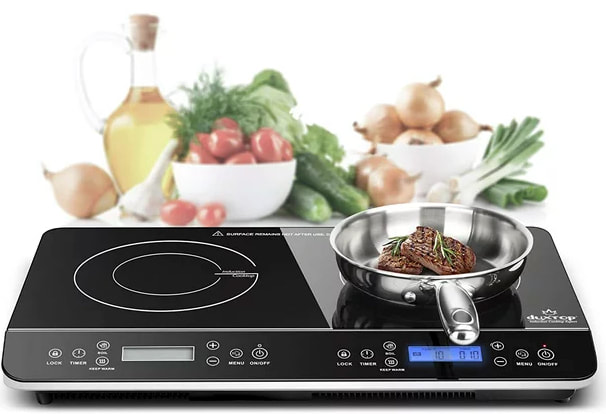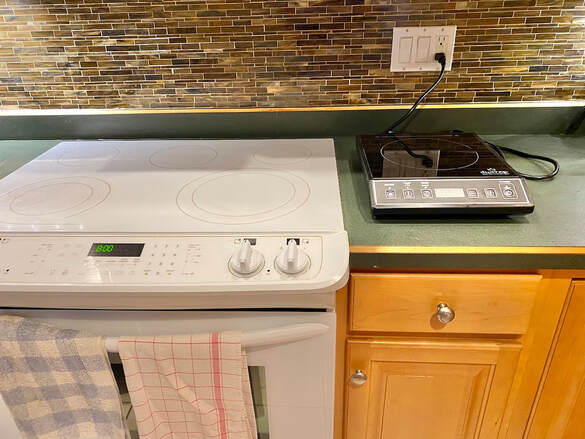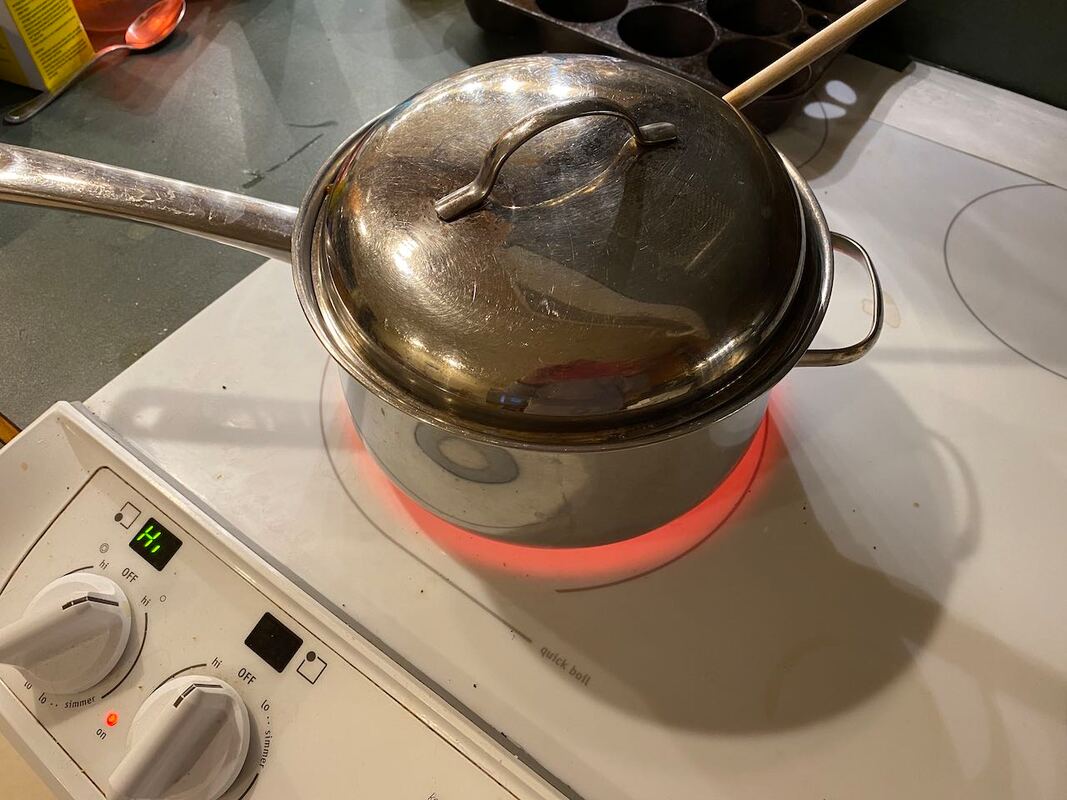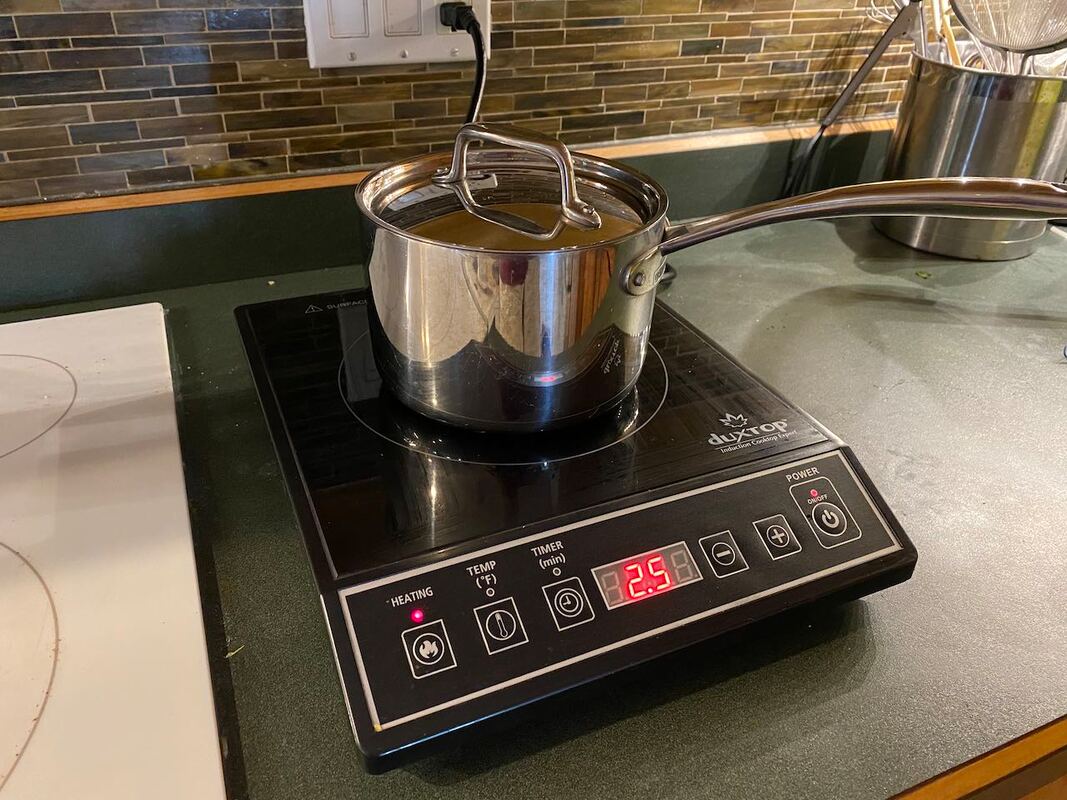Induction Cooking: The Three Basic Questions
1. Do I have to replace my stove or renovate my kitchen?
No. All you need is about a square foot of counter space, an ordinary 120 volt outlet, and about $100 to spare. Your local library may even have one you can borrow to try out.
2: Do I have to replace all my cookware?
No. You probably have at least a few items that will work right away. Use those on the induction cooktop, and use the others on your existing stove. You can buy more items, a few at a time, as your budget permits.
3: I love cooking on my gas stove! What about induction?
Most people like cooking on induction even better than gas or traditional electric. You get precise heat control that’s even more responsive than gas!
So, what are you waiting for? You can try cooking on induction right away.
No. All you need is about a square foot of counter space, an ordinary 120 volt outlet, and about $100 to spare. Your local library may even have one you can borrow to try out.
2: Do I have to replace all my cookware?
No. You probably have at least a few items that will work right away. Use those on the induction cooktop, and use the others on your existing stove. You can buy more items, a few at a time, as your budget permits.
3: I love cooking on my gas stove! What about induction?
Most people like cooking on induction even better than gas or traditional electric. You get precise heat control that’s even more responsive than gas!
So, what are you waiting for? You can try cooking on induction right away.
§ § §
OK, let’s be fair. There is one more question:
4: Do I need an electrician to install it?
Answer: Yes and no. Let’s cover the “no” first.
4: Do I need an electrician to install it?
Answer: Yes and no. Let’s cover the “no” first.
OK, now for the “Yes.”
• If you want to install a whole new stove, or a built-in induction cooking surface, then yes, you will need an electrician. That’s because anything more than 2 burners needs a 240 volt line connected to a dedicated circuit breaker. If you are replacing an conventional electric stove, the wiring for that can be used for the induction stove. New electrical codes require similar wiring in all new buildings, even if a gas stove is installed at first.
• If you want to install a whole new stove, or a built-in induction cooking surface, then yes, you will need an electrician. That’s because anything more than 2 burners needs a 240 volt line connected to a dedicated circuit breaker. If you are replacing an conventional electric stove, the wiring for that can be used for the induction stove. New electrical codes require similar wiring in all new buildings, even if a gas stove is installed at first.
We've been cooking Side-by-Side for over 2 years!
We moved into our new house in June of 2021. There was a ceramic top electric stove in the kitchen. We brought a single unit induction cooktop with us, placed it on the counter next to the stove, and plugged it in.
Since then, we have:
• cooked on the induction cooktop whenever possible, using cookware that works on it
• used the existing stove burners for cookware that's not induction compatible, or when we needed more than one pot on at once.
We use less energy because the induction cooktop is significantly more efficient. We enjoy the quick responsiveness , which is easily as fast or faster to change heat levels when compared to a gas burner, and way more responsive than conventional electric, whether you have traditional burners or a ceramic (smooth) surface.
• cooked on the induction cooktop whenever possible, using cookware that works on it
• used the existing stove burners for cookware that's not induction compatible, or when we needed more than one pot on at once.
We use less energy because the induction cooktop is significantly more efficient. We enjoy the quick responsiveness , which is easily as fast or faster to change heat levels when compared to a gas burner, and way more responsive than conventional electric, whether you have traditional burners or a ceramic (smooth) surface.
|
• Electric stove burners or conventional hot plates take longer to heat up, and longer to cool down when you adjust the heat setting. This wastes energy and makes cooking more difficult than it should be. It also risks burning food from excess heat. Cooks often have to lift pots off burners to prevent boiling over, etc.
• Electric burners let excess heat escape below, around, and above the cookware. This wastes energy, can heat pot handles unnecessarily (a risk to the cook!), and makes the kitchen a hotter place to work in, which is especially undesirable in the summer. • Electric stove burners stay dangerously hot right after being turned off. |
|
On an induction cooktop only the cookware itself heats up. It uses a fluctuating magnetic field to generate an electric current in the metal that forms the bottom of the cookware.
• This conserves energy, as only the pot itself heats up. • It's more responsive because there's no heating element to heat up or cool off when changing heat settings; the cookware itself is the only thing that retains heat. • Circuits within the unit automatically shut down if the pot is removed or overheats (such as if water boils away). • The risk of fires or burns caused by the burner itself are eliminated, as there is no exposed heating element or flame. This makes it safer than any other burner type. |
What about people who cook with gas? My partner Cathy had a gas stove in her last house. She thought she'd never give up gas fired cooking. Then she tried a stir fry on the induction cooktop using her favorite large carbon-steel frying pan. She was able to get a higher temperature, yet maintain exact control of the heat at all times. Now, she has found it as easy or even easier to cook with induction for everything.
Lately, we found even more reasons to avoid gas. There was a fatal gas explosion in our town due to a leak in the pipes under the street causing gas to seep into the basement of a house. We also read an article about the health effects of the air pollution emitted from open gas flames. People with asthma and other breathing problems are often have more symptoms from this indoor air pollution.
Lately, we found even more reasons to avoid gas. There was a fatal gas explosion in our town due to a leak in the pipes under the street causing gas to seep into the basement of a house. We also read an article about the health effects of the air pollution emitted from open gas flames. People with asthma and other breathing problems are often have more symptoms from this indoor air pollution.
Our conclusion: We definitely prefer cooking with the induction cooktop over our conventional electric stove. And, as we don't have gas service to the house now, we definitely don't plan to have it installed in the future.
For now, we'll continue to use our collection of older stainless steel and aluminum cookware on the electric stove when necessary and use induction for everything else.
In the future, we'll replace the few items of cookware with induction compatible ones and someday replace our stove with an induction model. As for the remaining cookware we have that is incompatible, we plan to donate it to charity.
Our recommendation: We encourage everyone to give this a try. Renters can get in on this since nothing in the kitchen needs to be modified. There's no risk to singeing or scorching the countertop as the bottom of induction units stays cool.
Single and dual burner induction cooking units are available for purchase online or at cooking supply retail shops and department stores for reasonable prices (starting at under $100).
Literature: You can download a PDF document that summarizes Side-by-Side induction cooking (see below).
For now, we'll continue to use our collection of older stainless steel and aluminum cookware on the electric stove when necessary and use induction for everything else.
In the future, we'll replace the few items of cookware with induction compatible ones and someday replace our stove with an induction model. As for the remaining cookware we have that is incompatible, we plan to donate it to charity.
Our recommendation: We encourage everyone to give this a try. Renters can get in on this since nothing in the kitchen needs to be modified. There's no risk to singeing or scorching the countertop as the bottom of induction units stays cool.
Single and dual burner induction cooking units are available for purchase online or at cooking supply retail shops and department stores for reasonable prices (starting at under $100).
Literature: You can download a PDF document that summarizes Side-by-Side induction cooking (see below).
| 2023_07_-_4_page_version.pdf |
References:
News story regarding the health risks of gas stoves.
The Massachusetts Clean Energy Center has a web page that gives more details.
This web site explains the science and engineering of induction for those who want to understand more about how it works.
News story regarding the health risks of gas stoves.
The Massachusetts Clean Energy Center has a web page that gives more details.
This web site explains the science and engineering of induction for those who want to understand more about how it works.
Update:
26 December 2021 - New York City - City government has now banned natural gas in new buildings constructed from now on. This is the largest city to do so, so far. The complete story is here. This is great news! Now, there is even more reason to try alternatives to gas for cooking, heat, or for domestic hot water.
26 December 2021 - New York City - City government has now banned natural gas in new buildings constructed from now on. This is the largest city to do so, so far. The complete story is here. This is great news! Now, there is even more reason to try alternatives to gas for cooking, heat, or for domestic hot water.



